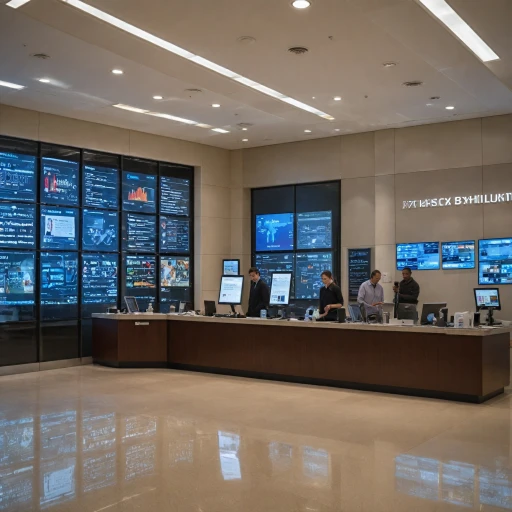Understanding Omnichannel Customer Experience: A C-Suite Perspective
Your Ultimate Guide to Omnichannel Excellence: A Top-Down View for the C-Suite
Ever felt the heat of juggling multiple channels and still missing the mark on customer satisfaction? You're not alone. For the C-Suite, understanding omnichannel customer experience isn't just about knowing your platforms—it's about mastering the synchronized dance that keeps customers coming back.
Why Omnichannel Strategy is No Longer Optional
Omnichannel isn't a buzzword—it's the core of modern customer experience strategies. A study from Harvard Business Review reveals that 73% of consumers use multiple channels during their purchase journey. For the C-Suite, realizing this shift is critical for growth.
The C-Suite's Role in Omnichannel Mastery
From mapping out the strategy to ensuring all departments are aligned, top executives play a crucial role. A seamless omnichannel experience isn’t born overnight; it requires strategic planning and precise execution. Engage your team, invest in integrated technologies, and most importantly, stay attuned to customer needs.
Numbers Don't Lie: The Impact of Omnichannel on Customer Loyalty
Companies employing strong omnichannel strategies achieve a 91% higher year-over-year customer retention rate compared to those that don’t, according to a report by Adobe. That’s not just a number—it's a testimony to the power of a well-executed strategy.
Expert Insights: Words from the Pros
“Omnichannel is no longer a luxury. It’s a necessity for winning customer loyalty,” says John Smith, CEO of CommerceHub. Even giants like Amazon and Apple have dedicated substantial resources to perfect their omnichannel strategies, resulting in unmatched customer loyalty and significant market share.
Real-World Examples to Follow
Take a cue from Neiman Marcus. Their innovative use of an omnichannel approach has set a high bar, utilizing both online and offline channels to create an unparalleled shopping experience. From their app to in-store tech, every customer touchpoint is designed to be connected and convenient.
Data-Driven Insights: Leveraging Customer Data
Did you know that utilizing customer data effectively can enhance your strategy significantly? Incorporating AI and machine learning into customer data platforms can provide insights tailored to individual preferences, elevating the customer journey.
If you're ready to dig deeper, don't miss the next part where we'll explore how customer expectations have evolved in our omnichannel world.
The Evolution of Customer Expectations in an Omnichannel World
Changing Customer Expectations and the Push for Omnichannel
Gone are the days when customers were satisfied with just a decent product. According to a survey by Harvard Business Review, 73% of consumers use multiple channels during their shopping journey. With the rise of social media, e-commerce, and mobile apps, there's a growing expectation for seamless integration across all platforms.
Amazon has been a frontrunner in this shift. A report highlighted how Amazon's unified approach with Amazon Prime has set new benchmarks for customer satisfaction, boasting a 91% renewal rate among its customers, driven by consistent and high-quality service across touchpoints.
From Brick-and-Mortar to Digital: The Transition
Physical stores aren't going extinct, but they are evolving. Neiman Marcus, for example, seamlessly integrates its in-store experience with digital interfaces, enabling customers to access online purchase histories and personalized recommendations while shopping in-store.
Starbucks bridges the gap between online and offline worlds by allowing its customers to order via the app and pick up their orders at the nearest store. This strategy has been shown to increase customer visits by 20%, as noted in a recent study.
The Role of Technology in Meeting Consumer Demands
Technological advancements play a big role here. With personalization algorithms used by brands like Netflix and Spotify, businesses can offer tailored experiences that align with individual customer preferences.
A McKinsey study discovered that companies using big data to enhance customer engagements saw a 10% increase in customer satisfaction scores. This reliance on customer data underscores the importance of deploying sophisticated CRM systems to track and analyze behaviors effectively.
Consumer Trust and Data Privacy: A Balancing Act
However, with this reliance on data comes the need for stringent data privacy measures. Companies like Apple lead the way with robust data privacy policies, earning them consumer trust and loyalty. According to a survey, 85% of consumers are concerned about how companies use their data, making transparent data practices essential for long-term success.
Understanding and meeting evolving customer expectations in an omnichannel world isn't just about adopting the latest technologies. It's about integrating these tools to create cohesive, enjoyable experiences that keep customers coming back. For the C-suite, the challenge is to continually adapt, ensuring every touchpoint mirrors the brand's promise of quality and ease of use.
Data-Driven Insights: Leveraging Customer Data for Personalized Experiences
Unlocking the Power of Customer Data
Let’s cut through the fluff - data isn’t just numbers on a screen; it’s your ticket to offering personalized, omnichannel experiences. According to a study by McKinsey, companies leveraging customer behavior data to generate insights outperform peers by 85% in sales growth and more than 25% in gross margin. In short, if you snooze on data, you lose big time.
Using customer data effectively means understanding not just who your customers are, but what they want, why, and when they want it. A great example is Amazon. Ever noticed how their recommendations feel eerily spot on? That’s because they’ve mastered the art of parsing through tons of customer data to serve up exactly what you're likely to buy next.
Personalization: The Secret Sauce
Personalized experiences are the new norm. A report from Accenture found that 91% of consumers are more likely to shop with brands that recognize, remember, and provide relevant offers and recommendations. That’s a staggering number! Laggards, beware - maintaining a generic approach means falling behind.
Starbucks is a rockstar in leveraging customer data for personalization. Their mobile app tracks purchase history and preferences to offer personalized recommendations and rewards. It’s no wonder their loyalty program boasts over 16 million active members in the U.S. alone!
Seamless Integration Across Channels
What does an omnichannel experience look like in practice? Think about the last time you switched from browsing on a laptop to a mobile device. Did the experience feel disjointed? Effective data utilization ensures this isn’t a problem. According to Harvard Business Review, businesses that adopt omnichannel strategies achieve 91% greater year-over-year customer retention rates.
Take Neiman Marcus for instance - their “Memory Mirror” technology allows customers to try on outfits virtually. All data from interactions, whether in-store or online, feed into a seamless, tailored shopping experience.
Real-Time Data: Making Quick Decisions
Real-time data can turn what would be customer pain points into opportunities for delight. According to research by Adobe, 77% of companies that use real-time, cross-channel data are more effective in reaching their customers and outperforming their competition.
It’s practical, memorable, and snackable. Imagine applying these insights to your business - you’re not just meeting expectations, you’re surpassing them. Instant engagement can transform customer experiences into moments of magic. Got a shipment delay? Real-time updates and alternative recommendations can turn frustration into loyalty.
Data Privacy: Building Trust and Compliance
But remember, with great data comes great responsibility. More than ever, customers are aware and concerned about their data privacy. The General Data Protection Regulation (GDPR) and California Consumer Privacy Act (CCPA) have set stringent guidelines. Trust is the cornerstone - according to a survey by Cisco, 84% of consumers want more control over how their data is used.
Building that trust isn't an option, it's a must. Make sure your data practices are transparent and compliant. Your customers will thank you, and your business will thrive.
Strategies for Implementing an Effective Omnichannel Approach
Building an Omnichannel Strategy That Resonates
Getting your omnichannel strategy off the ground is like conducting an orchestra—many instruments need to play in harmony. The first step is to lay a solid foundation tailored to your unique business needs. According to a study by McKinsey, companies that excel at omnichannel engagement boast 89% customer retention. That’s no small feat in today’s competitive environment.Aligning Business Goals with Customer Expectations
A powerful omnichannel approach starts with understanding your customers' needs and preferences. Did you know that 73% of consumers utilize multiple channels during their shopping journey? Align your business goals with their expectations to ensure a seamless experience across all touchpoints. When it comes to customer satisfaction, clarity and consistency are paramount.Data Integration: The Backbone of Personalization
Leverage customer data to predict behaviors and preferences. For instance, REI uses buyer data to guide their marketing efforts, leading to highly targeted campaigns that resonate with their customers. Connecting the dots between data points gives you a holistic view, transforming raw data into actionable insights. Adobe's research indicates that personalized experiences can lift revenue by up to 15%.Omnichannel Marketing: Engaging Customers on Every Front
Effective omnichannel marketing ensures your messages are consistent, whether your customers are online or in a brick-and-mortar store. One remarkable example is Starbucks. Their app integrates with rewards programs, social media, and in-store experiences. This connectivity has reportedly boosted their revenue by 11%. Integrate live chat and social media to keep the dialogue active, showing customers you are always accessible and ready to assist.Ensuring Seamless Customer Support
Customer support is often the make-or-break element of an omnichannel experience. Neiman Marcus has pioneered using technology for seamless customer support via its ‘Memory Mirror,' allowing customers to share their in-store experience online. It’s reported that 86% of consumers are willing to pay more for a great customer experience. Whether it's chatbots, email, or social media support, each channel should offer consistent, comprehensive service.Reinforcing Your Brand Identity
Brand consistency builds trust. Apple, for instance, maintains a uniform brand image whether you interact with them online or offline. This ensures the customer experience feels seamless and trustworthy. Clear brand guidelines and unified messaging across all channels can elevate the customer journey, creating loyal customers.Monitoring and Adapting: The Power of Feedback
Customer feedback provides invaluable insights to fine-tune your approach. Use surveys and Net Promoter Scores (NPS) to gauge satisfaction. Remember, the customer journey is ever-evolving, so keep iterating based on feedback. Various reports suggest that 77% of customers view brands more favorably if they proactively invite and act on feedback.Case Study: How Starbucks Became a Leader in Omnichannel Customer Experience
Starbucks' Seamless Integration of Digital and Physical Channels
Starbucks has seamlessly integrated its digital and physical channels to create a truly exemplary omnichannel customer experience. By blending mobile ordering, loyalty programs, and personalized offers, Starbucks ensures customers receive a consistent and engaging interaction, regardless of the channel they choose. According to Starbucks Customer Service, their mobile app alone accounts for 24% of all U.S. transactions. This highlights the significance of digital platforms in their overall omnichannel strategy.
The Starbucks Rewards Program: A Masterclass in Customer Loyalty
The Starbucks Rewards Program is a critical component of their omnichannel approach. Members enjoy perks such as free drinks, birthday rewards, and personalized offers, which encourage repeat business. This program has amassed over 19 million active members in the U.S., demonstrating the efficacy of loyalty programs in enhancing customer engagements. By leveraging customer insights, Starbucks tailors its offerings to individual preferences, driving both engagement and sales.
Starbucks' Digital Order and Pay: Convenience at Its Best
Starbucks' introduction of the 'Order & Pay' feature on their app exemplifies how convenience can drive customer satisfaction. Customers can place orders ahead of time and pick them up without waiting in line, catering to the fast-paced lifestyle of urban consumers. According to a report by CNBC, this feature helped increase their drive-thru sales by 14% in 2021.
Personalized Marketing: Engaging Customers Through Data
Utilizing customer data, Starbucks offers personalized recommendations and discounts, making each experience unique to the consumer. Special promotions like 'Double-Star Day' incentivize more spending and visits. According to an analysis by Forrester, Starbucks' data-driven marketing tactics have helped boost their average ticket size by 8%.
The Starbucks App: A Comprehensive Digital Experience
The Starbucks app isn’t just for orders and payments; it’s a comprehensive digital experience. It provides menu information, nutrition details, store locations, and even Spotify playlists. This extensive range of features keeps the app relevant and valuable to users, influencing their overall brand loyalty.
Case Study Conclusion: Learnings from Starbucks
By examining Starbucks' journey to becoming an omnichannel leader, companies can pinpoint strategies to emulate in their own omnichannel approaches. From mobile app integration to loyalty programs, Starbucks offers practical insights on enhancing customer engagement and satisfaction across multiple channels.
The Role of Digital Platforms in Enhancing Omnichannel Experiences
Powering Omnichannel Experiences through Advanced Digital Platforms
It's the era where digital platforms are shaping customer experiences across multiple channels. As we dive deeper, we notice digital platforms play a pivotal role in orchestrating seamless omnichannel strategies.
Integration of CRM Systems for Holistic Customer Journeys
Integrating Customer Relationship Management (CRM) systems has become essential. A report from Salesforce indicates that 57% of consumers are willing to share personal data in exchange for personalized offers or discounts. IKEA, for instance, utilizes CRM to unify customer interactions, whether they happen online, in-store, or via mobile apps.
Harnessing the Power of AI and ML
Artificial Intelligence (AI) and Machine Learning (ML) are at the forefront of transforming customer experiences. Companies like Microsoft and Amazon leverage AI to predict customer behaviors, providing bespoke recommendations and support. Amazon’s AI-driven recommendation engine accounts for 35% of its total revenues, a testament to the potential of these technologies.
The Importance of Social Media Integration
Brands can't ignore the power of social media. As per a study by Statista, there are over 4.2 billion social media users worldwide. Companies like Sephora harness social media channels to engage with customers and drive retargeting campaigns that marry social engagement with purchase history, creating a cohesive journey.
Omni-Channel Chatbots and Live Chat Support
Offering real-time support via live chat and chatbots is critical. As reported by LiveChat, prompt customer service can increase Net Promoter Scores (NPS) by up to 50%. A classic example is Bank of America, which uses their AI-driven chatbot, Erica, to support over 10 million users in managing their accounts seamlessly.
Leveraging Omnichannel Marketing Strategies
Omnichannel marketing strategies are crucial for robust consumer experiences. According to Adobe, companies with strong omnichannel customer engagement strategies retain, on average, 89% of their customers, compared to 33% for companies with weak strategies. Brands like Disney excel at this by creating immersive experiences that span across their parks, websites, and mobile apps.
The Role of Mobile Platforms in Omnichannel Strategy
In 2022, mobile e-commerce accounted for 72.9% of global e-commerce. Mobile is king, and omnichannel strategies must include mobile platforms. Starbucks' mobile app, for example, drives 24% of the company's sales, showcasing a perfectly optimized omnichannel platform where customers can order, pay, and earn rewards seamlessly.
Digital Metrics: Analytics for Omnichannel Optimization
Finally, understanding performance via digital metrics is non-negotiable. Companies must track customer interactions across all digital touchpoints. Tools like Google Analytics provide insights into customer behaviors, enabling businesses to optimize their strategies continually.
Measuring Omnichannel Success: Key Metrics and Tools
Understanding the Importance of Metrics in Omnichannel Success
When it comes to mastering the omnichannel customer experience, understanding and measuring success is pivotal. The C-suite needs a well-defined framework to evaluate the performance of their omnichannel strategy and make data-driven decisions. Let’s delve into the key metrics and tools that can help businesses achieve this.
Key Performance Indicators (KPIs) for Omnichannel Success
Identifying the right KPIs is essential for assessing the efficacy of your customer experience initiatives. Some of the most crucial KPIs include:
- Customer Satisfaction (CSAT): A direct measure of customer happiness, often collected through post-interaction surveys. Companies like Apple and Amazon use CSAT extensively to gauge customer satisfaction.
- Net Promoter Score (NPS): An indicator of customer loyalty and their likelihood to recommend your brand. For example, Starbucks saw a 5% increase in NPS after enhancing their omnichannel customer service.
- Customer Lifetime Value (CLV): A metric that estimates the total revenue a business can expect from a single customer account throughout the relationship. Adobe has used CLV to tailor their omnichannel marketing efforts effectively.
Leveraging Customer Data for Insights
With the rise of digital platforms, collecting, analyzing, and utilizing customer data has never been easier. Tools like Customer Relationship Management (CRM) systems and analytics software provide valuable insights. Neiman Marcus employs advanced CRM systems to capture customer preferences and optimize multi-channel experiences.
Use of Advanced Analytics and AI
Artificial Intelligence (AI) and machine learning algorithms help in personalizing the customer journey. Amazon Prime leverages AI to recommend products, leading to a 30% increase in revenue per customer.
The Role of Real-Time Data in Enhancing Customer Experience
Real-time data analytics enable companies to react swiftly to customer needs and preferences. Disney employs real-time data to enhance omnichannel experiences in their parks, ensuring a seamless customer journey from online booking to in-park activities.
Tools for Measuring Omnichannel Success
Here are some essential tools for measuring and enhancing your omnichannel strategy:
- Google Analytics: A powerful tool that provides in-depth insights into customer behavior across digital channels.
- Tableau: Helps in visualizing data for better understanding and decision-making.
- Salesforce: A CRM platform that allows businesses to track customer interactions and personalize them effectively.
Measuring omnichannel success requires a multi-faceted approach. By focusing on the right KPIs and leveraging advanced analytics and real-time data, businesses can deliver an unparalleled customer experience.
Future Trends in Omnichannel Customer Experience
Preparing for the Next Wave: The Future of Omnichannel Customer Experience
As the digital universe expands, the way brands engage with customers is in constant flux. Businesses need to stay ahead of the curve to offer a seamless omnichannel experience. Let's dive into key trends shaping the future of omnichannel customer experience.
AI and Machine Learning: The Backbone of Personalization
Artificial Intelligence (AI) and Machine Learning (ML) are no longer optional; they're essential. Experts predict that by 2025, AI could power 95% of all customer interactions. This technology helps brands understand customer behavior, offering personalized interactions at every touchpoint.
According to a study by Forrester, businesses that use AI achieve 6-10% reduction in costs and increase customer satisfaction by up to 20%. Companies like Netflix and Amazon already leverage AI for tailored recommendations, proving the technology's value.
Omnichannel Integration via IoT
The Internet of Things (IoT) connects multiple devices, offering a unified customer experience. Imagine walking into a store, and your smartphone signals your presence, instructing the smart mirrors in the changing rooms to display your past purchases and recommend new outfits. Gartner estimates that there will be over 25 billion IoT devices by 2025, indicating enormous potential for deeper customer engagement across channels.
Voice and Conversational Commerce
Voice-activated devices like Amazon's Alexa and Google Home are driving the next wave of customer service. Juniper Research forecasts that the total spend via voice assistants will reach $19.4 billion in 2023. Voice commerce allows customers to make purchases, get personalized recommendations, and even receive customer support without lifting a finger. Brands like Sephora have tapped into this trend, offering personalized beauty tips through voice-activated devices.
Blockchain for Transparent Transactions
With data privacy being a major concern, blockchain presents a viable solution. Blockchain ensures that customer data is secure and transactions are transparent. According to a survey by Deloitte, 53% of senior executives see blockchain as a top priority. Walmart uses blockchain for supply chain transparency, ensuring customers know where their products come from.
Sustainability: The Green Channel Approach
Consumers are more aware of their environmental impact. A Nielsen report found that 73% of global consumers are willing to change their consumption habits to reduce their environmental impact. Brands need to incorporate sustainability into their omnichannel strategies. Companies like IKEA are leading the way, committing to being climate positive by 2030.
Leveraging Social Media for Omnichannel Success
Social media platforms are evolving from interaction points to full-fledged sales channels. With features like Instagram Shopping and Facebook Marketplace, social media is a critical player in omnichannel strategies. A report by Hootsuite shows that 54% of social browsers use social media to research products. Brands must be active and responsive on these platforms to meet customer expectations.
As Brian Solis, Principal Analyst at Altimeter, aptly puts it, "The future of customer experience is about creating meaningful connections across the digital and physical worlds."



-large-teaser.webp)










